My cat has diabetes: now what? (Part I)
The role of your vet, hypoglycemia, and home blood sugar checks
The first sign was Mosi’s increased hunger. Despite ravenous appetite, she was losing weight. She also seemed to be drinking more than usual. We took her in for a check and, after a blood draw, were informed that she had diabetes mellitus. As the vet handed us an explanatory sheet and started talking about insulin injections and blood glucose checks, I felt my stomach sinking. I was prepared to do whatever it took to help Mosi. But still, it all seemed so daunting.
The beginning was difficult. Mosi had an episode of low blood sugar (hypoglycemia, a potentially life-threatening condition everyone caring for a diabetic fears) and we thought we would lose her. Other complications followed. Then, a new approach was found to treat both her diabetes and other issues caused by her malfunctioning pancreas. The new treatment, combining a different kind of insulin with a daily probiotic and vitamin supplementation, including a weekly injection of Vitamin B12, brought quick results.
Soon after, Mosi accompanied us on vacation. Leaving Mosi with her furry sisters to be cared for by a pet sitter wasn’t possible, as we needed to keep a close eye on her. It was not the easiest experience, and must have been much harder for her than for us, but we made so many memories with this brave, intrepid little animal.
Mosi, an elderly (17-18 at the time), indoor-only cat explored everything with gusto, ate well, and slept with us during stopovers on the way to and from our destination, a small village in Italy. In the car, she mostly refused to sit in the back in the oversized carrier we bought (the safest option). Instead, she rode nestled in my lap, her mitten paws draped over a neck pillow, surveying the passing cars and astonishing other motorists. During rest stops, she walked around, ate, and relaxed in the greenery.
My husband calls the photo album I made of this trip “Mosi’s great European vacation” as photos of Mosi outnumber all others by about 10:1 (as they should!). This trip was a source of inspiration for my post on traveling with your cat, which you can find here.
Here you have:
Top row: (1) Mosi and me during one of the rest stops checking out the driver’s seat. (2) Mosi having lunch, the Stelvio Pass, Italy. Stelvio is very famous with bikers and motorists. We were the only group with a cat that day. (3) Mosi exploring a fish pond at our accommodation in France.
Middle row: (1) Mosi looking out the window during a driving break in Switzerland. (2) Mosi holding my husband’s hand as he drives (look at that mitten paw!). (3) Mosi channeling one of her big cat relatives, during a stop in the Swiss Alps.
Bottom row: (1) Mosi alert and not intimidated, even though she hasn’t been in a car for years (apart from going to the vet). (2) Mosi exploring during a rest stop, her oversized carrier in the background. (3) Mosi enjoying the sunshine at our accommodation in France. She used the stone pathway as she explored the yard, like a very disciplined person.
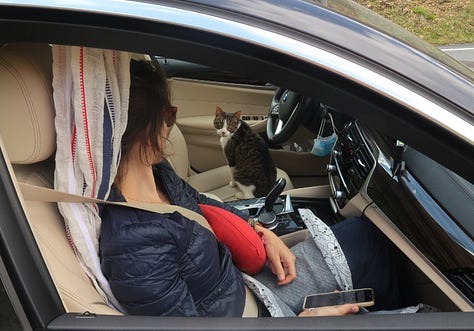
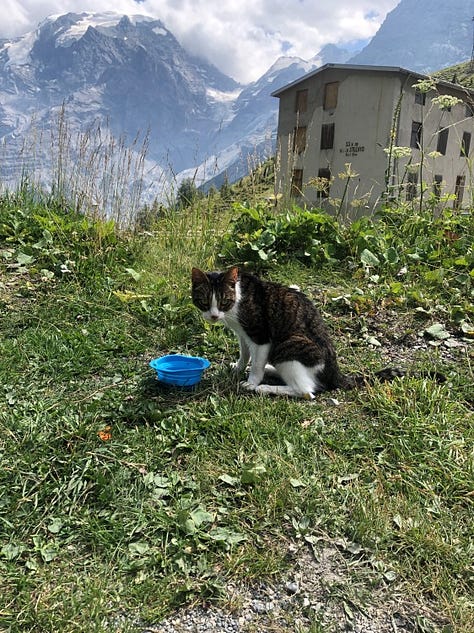
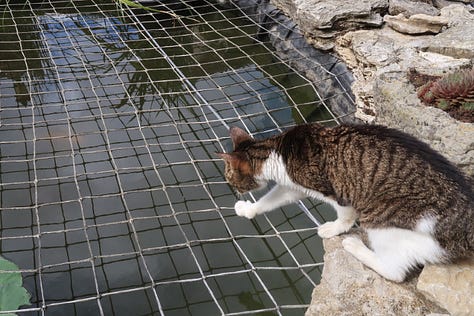

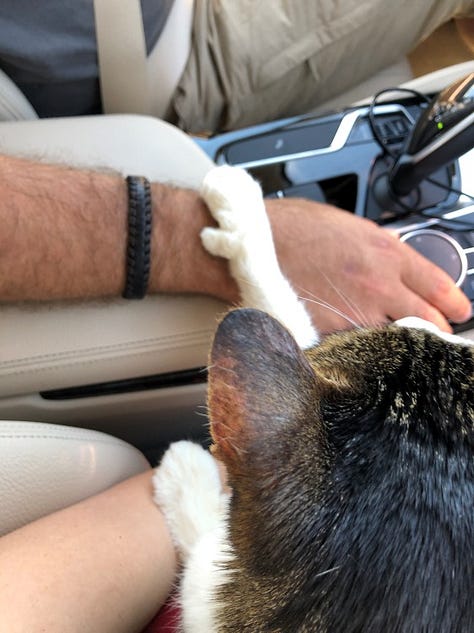




Gradually, we learned the basics of diabetic care and adjusted our lives. It was not easy. At times, it was heartbreakingly, impossibly hard. And we made mistakes. But we never gave up and managed to have four more years with Mosi. Today, I’d like to share some of what I learned.
Stay close to your veterinary team
Your veterinary team will recommend the most suitable therapy. The usual approach with insulin injections is to start with a lower dose and gradually increase it until the cat’s blood glucose levels are controlled but don’t dip too low. The vets can check your cat’s blood glucose and teach you to do it at home. Bringing your cat to the vet every time you need to measure it is not practical. In addition, a vet visit is a stressful event for the cat, which causes blood glucose to spike, distorting the clinical picture.
Your veterinary team can also suggest monitoring or treatment alternatives as they become available. Some cats can now be treated with pills instead of injections. And for some caretakers, injecting using special injection pens can be easier than using syringes.
At one point, we tried a blood glucose monitoring sensor to get a clearer picture of Mosi’s blood glucose fluctuations. It did not function consistently well, though while it did, it was a huge relief to see Mosi’s blood sugar simply by holding my phone next to the sensor attached to her skin. Ultimately, we weren’t prepared to subject Mosi, a thin and nearly 20-year old cat at the time, to the stress and discomfort of continuously wearing a large sensor surgically glued to her shaved skin. Once a sensor stopped working, it took days of applying baby oil to the skin before we could remove it. With her parchment-thin skin, it was quite a delicate process.
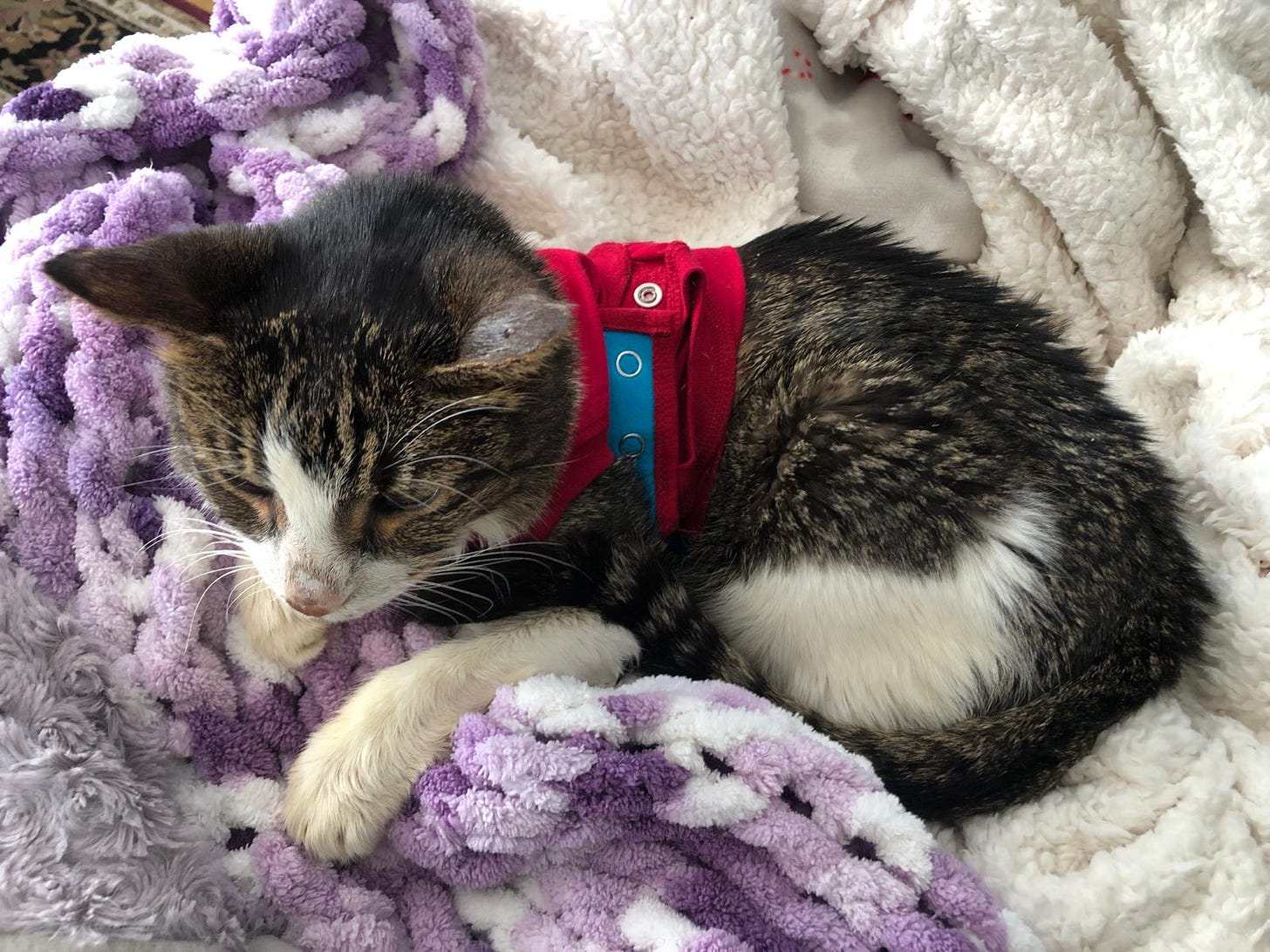
As diabetic cats can go into remission without warning, regular monitoring is essential, even if you believe your cat’s diabetes to be well-controlled. And if your diabetic cat is senior, close monitoring becomes even more important. For senior cats (8 and older), the recommended check-up frequency is twice a year. Once Mosi became diabetic, we saw the veterinary team much more often than that.
If you see a new veterinarian, make sure she knows that your cat has diabetes, as diabetes can significantly affect treatment options for other issues. For example, diabetic cats cannot receive steroid treatments as those can cause a significant increase in blood sugar levels (High Blood Sugar In Cats, PetMD). Other health concerns can sometimes lead to changes in recommended diet or other treatment plan adjustments. For example, Mosi had inflammatory bowel disease and absorption issues, and the veterinarian recommended gastrointestinal food for her in place of diabetic.
Hypoglycemia: the greatest risk
From the start, our vets have warned that the greatest risk to Mosi was hypoglycemia (abnormally low blood sugar levels). Hypoglycemia can occur when a diabetic cat receives too much insulin relative to his or her starting blood sugar levels. Symptoms include “weakness, lethargy, vomiting, lack of coordination, seizures, and coma” (Feline Diabetes, Cornell Feline Health Center). With Mosi, hypoglycemia generally manifested as quietness and lethargy, but if you are dealing with an elderly animal, it can be difficult to distinguish the normal “resting in the afternoon” quiet from the hypoglycemia-induced “about to die” quiet. (One time, it looked different: she was acting abnormally hyper and smelling everything, eyes unfocused, so symptoms can vary for the same animal from one time to the next.) Because signs of hypoglycemia can be subtle, it is important to become familiar with your cat’s normal behavior and be alert to any changes. Cat Specialist Services include a good summary of the symptoms of hypoglycemia and the recommended actions.
Hypoglycemia requires immediate attention. Like, drop everything and rub honey on your cat’s gums immediate. There is no time to drive to the vet or even call the vet. Our hypoglycemia protocol, based on veterinary advice, was: (1) rub honey on Mosi’s gums as soon as possible (sometimes we also mixed honey with a bit of warm water and injected it into her mouth with a small needleless syringe); (2) call the vet to report the issue and get advice; (3) check blood sugar every 20 min for 60-90 minutes; (4) skip the following injection.
Even cats with well-regulated diabetes can develop hypoglycemia, for example, if they do not eat as usual, vomit, or if increased levels of activity are not compensated for by increased food intake. I recall reading a story of hypoglycemia being brought on by play with a visiting child. If your diabetic cat has to stay alone for long periods of time, the safest approach is to inject a lower dose before you leave.
Learn to check blood glucose
Blood glucose checks were the most stressful aspect of managing Mosi’s diabetes. I worried about hurting her and damaging her ears. At some point, we switched to her toe pads, but without much success. I could not stab her kitty toes with the vet-recommended large 25-gauge needle. But being able to check your cat’s blood glucose level is essential for ongoing treatment and can be life-saving, so we persisted.
The equipment
I used a human blood glucose monitor called OneTouch Verio, a system similar to that used at my veterinary clinic. It has an accompanying app that lets you keep track of your cat’s readings. (Some sources suggest that monitors designed for humans may not work as well on cats as their blood characteristics differ. My vet reassured me that this was not the case.) The monitoring kit includes the device itself, some test strips, and a lancing device (the white pen-like device in the image below) along with disposable lancets (the gray plastic ‘sticks’). The lancing device should be adjusted to draw enough blood to get a reading, but not so much as to draw too much blood and damage the ear.
You will need to buy additional test strips and lancets as you go. (Don’t re-use the lancets as they get duller with each use and may damage your cat’s ear.) I also suggest buying a testing solution. Every time you open a new box of testing strips, and whenever in doubt about the glucose readings, test the strips with a control solution of the same brand as your monitor.
The process
I found this source recommending warming a washcloth (I microwaved a sock filled with salt) and gently applying it to your cat’s ear, taking care not to overheat it, prior to testing. To prevent overheating, I checked the temperature carefully and only applied it to Mosi’s ear intermittently. Once the ear seemed warm, I applied a little bit of Vaseline to prevent the blood from disappearing into the fur and used a cotton pad under the ear. I tried to test not directly in the blood vessel but next to it to avoid trauma and excessive bleeding. After drawing a small drop and applying the test strip, I pressed the cotton pad around the puncture site for a few seconds to make sure the blood stopped.
It is best to alternate ears and sampling sites, staying along the outside edges of the ear flap. With Mosi, certain spots were consistently easier to draw blood from, and one of her ears seemed much more sensitive than the other, so in the end, I sampled mostly from the upper/mid part of her right ear.
During four years of managing Mosi’s diabetes, we checked her blood glucose probably hundreds of times. There were periods during which we checked less frequently - once a week, or even once every few weeks. And there were periods during which we checked several times a day. I also didn’t always manage to draw enough blood (and had to repeat the process until I did), or drew too much. Once, I ran out of testing strips and had to call pharmacies all over town and rush to our vet in an effort to get some on a Saturday evening. A few times, I hit a vein in her ear.
Despite my best intentions and immense love for Mosi, I made mistakes as I navigated her treatment. All I can say is be careful and attentive with your cat, but also try to be gentle with yourself. Caring for a diabetic animal can be complicated and emotional. They can’t tell us how they feel, and we are not veterinary professionals. We are all just trying to help our furry family members as best we can.
In Part II, I will talk about injections, managing your absences, taking care with syringes and insulin, and trusting your intuition.
Have you ever cared for a diabetic cat? Please share your experience and any questions you’d like answered in the comments.
This essay has been checked by a veterinary professional, but I am not a vet and each cat’s situation is unique. If in doubt, check with your vet.
If you found this essay useful and would like to support my work, you have the option of doing so here:
or here:


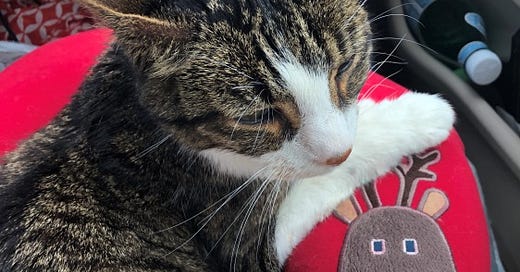



Beautiful pictures of a unique kitty. Even with her diabetes, she had a wonderful personality and enjoyed every moment of her life! ❤️
Sure above is very helpful for all cats with diabetes. You did so well in all these years 💪!
Sweet Mosi❣️🐾
Thank you for sharing this. It was so informative. We’ve never had a cat with diabetes, but we had one years ago with FIV. Someone had abandoned him at the station. We nursed him for a year before he left us.
Ten, one of the three we have now, has hyperthyroidism, so we consult regularly with our vet.
As you say, these little family members can’t tell us what’s going on, so we just have to do the best we can.